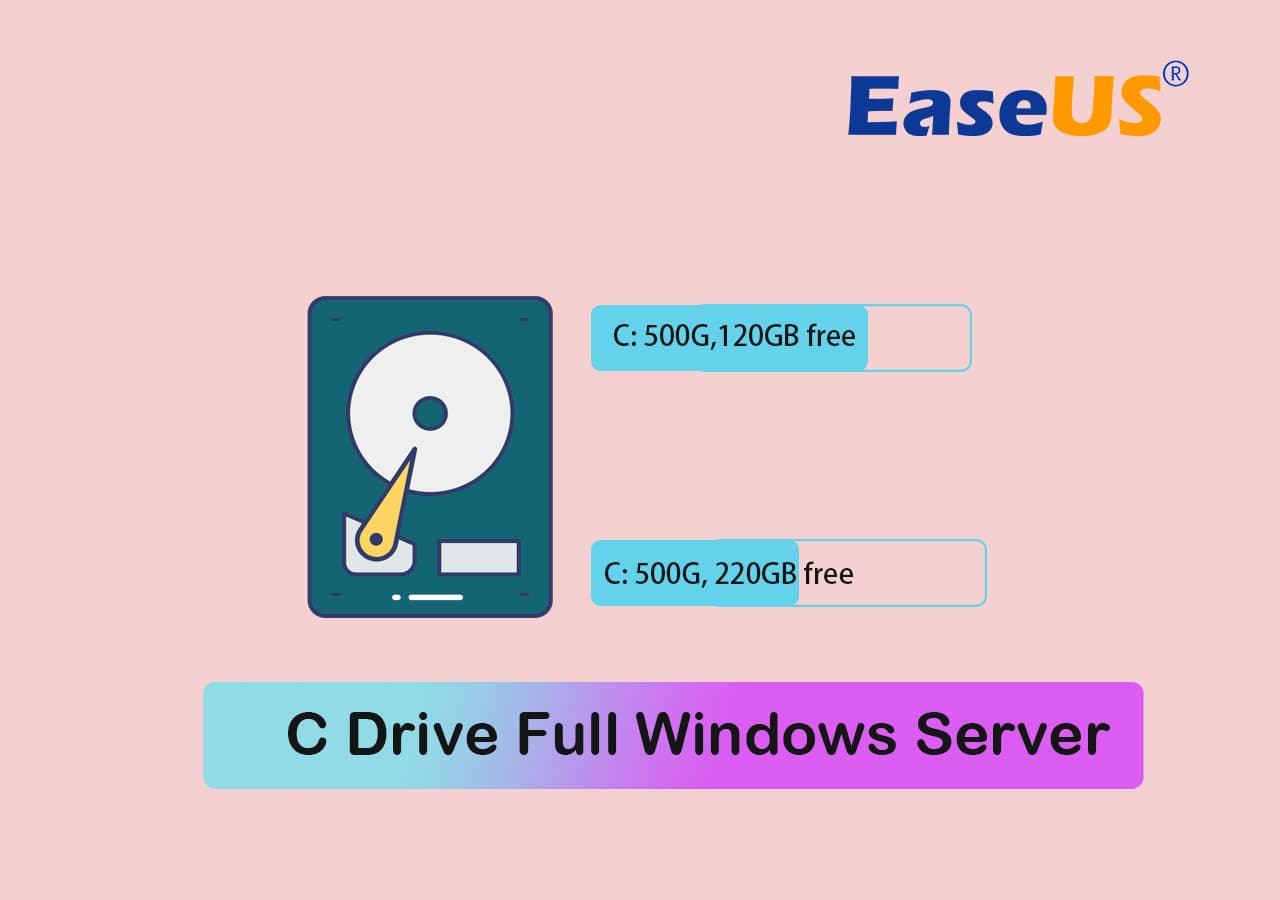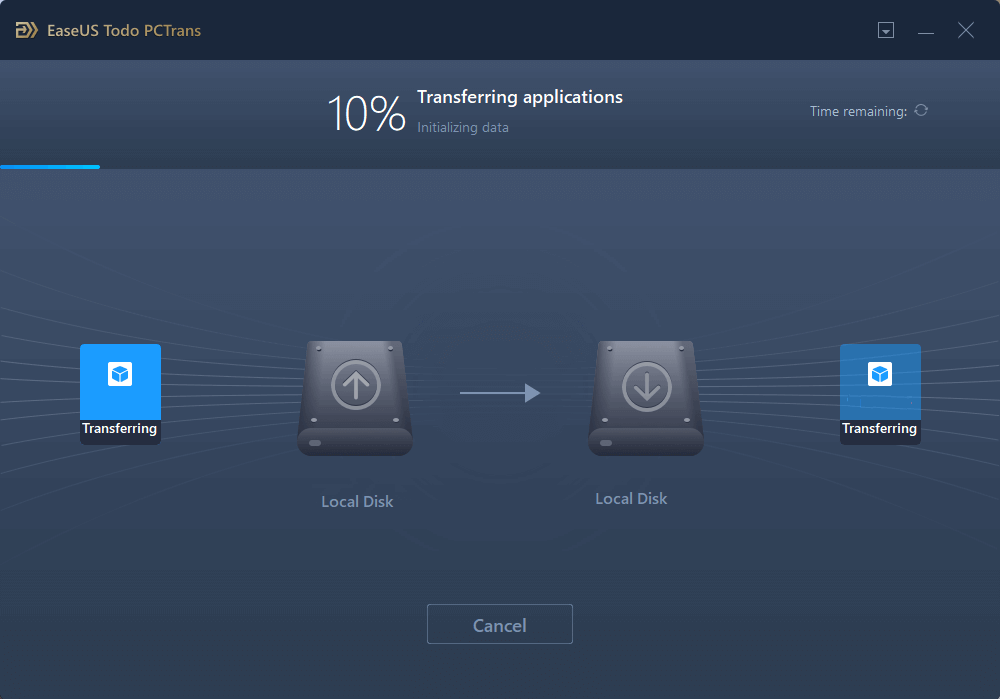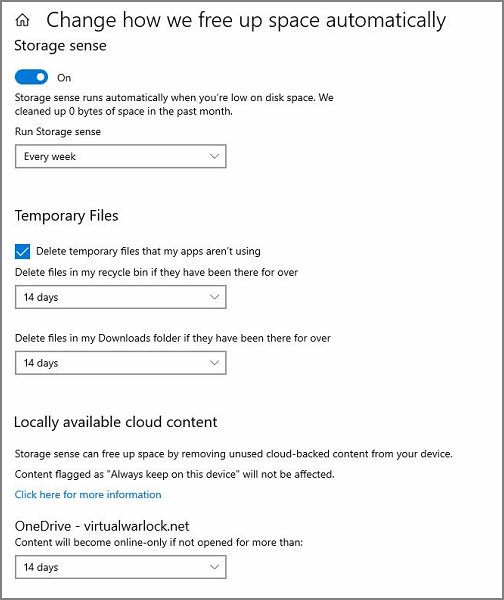Page Table of Contents
Reviews and Awards
Stay calm when your Server computer becomes slow to boot up, stuck in file transferring, or programs reluctant to launch. A high reason is because your C drive gets full in Windows Servers. Take the following methods to quickly fix this issue now.
5 Methods to Get Rid of Windows Server C Drive Full Issue
The previous section explained the issues that you will face if your C drive is full. But, some solutions help you to free up space on your C drive. One method also explains how to expand your C drive's storage space by modifying existing partitions.
Below is the list of methods that can help you get rid of the Windows Server C drive full issue:
1. Migrate Installed Programs from C Drive to Another Drive
2. Run Disk Cleanup
3. Run System Cleanup and Large File Cleanup in C Drive
4. Add More Space to System C Drive
5. Turn on Storage Sense

Method 1. Migrate Installed Programs from C Drive to Another Drive
Your Windows Server C drive can be full due to too many application programs installed in it. You can fix this by migrating installed programs from a C drive to another drive on your Windows Server.
However, the application migration is not as simple as copy-pasting the application from one location to another. The reason is that an application consists of tons of libraries and dependent modules that need to be moved appropriately.
EaseUS Todo PCTrans Technician, with its App Migration feature, could help. It allows you to move installed programs from a C drive to another drive on Server computers without redownloading nor reinstalling apps.
Follow the below steps to easily migrate installed programs from C drive to another drive on Windows Server:
Step 1. Run EaseUS Todo PCTrans on your PC
Go to "Loacal Migration" and click "Start" to continue.

Step 2. Select programs to move from C drive to another drive
1. Tick the C drive and select programs (marked as "Yes") that you want to transfer.
2. Click the triangle icon to select another drive on your computer as the destination, and click "Transfer" to start the process.

Step 3. Finish the transferring
Wait patiently until the transferring process finishes and click "OK" to confirm.

When it has done, you can restart PC if necessary. This will keep all changes on your PC and then you can run and programs from another hard drive without reinstallation.
Method 2. Run Disk Cleanup
The C drive on Windows Server holds all kinds of files related to your applications and server. Some of the files on the C drive are unnecessary and can take up a lot of space. These temporary files are usually application logs or cached files.
You can run Disk Cleanup which can remove all the unnecessary files on your Windows Server C Drive. Follow the below steps to run Disk Cleanup on your Windows Server.
Step 1: Open the properties of your Windows Server C drive.
You can open the C drive properties by going to your file explorer, right-clicking on the C drive, and choosing properties.

Step 2: Choice Disk Cleanup from the opened pop-up window.
Step 3: Disk Cleanup will show you the possible space to free on your C drive.
Step 4: Select the files you do not need and tick them. Once done, press the OK button.

Method 3. Run System Cleanup and Large File Cleanup
You can also use it to perform system cleanup and clean large files on your Windows Server C drive. With EaseUS Todo PCTrans Technician, you can quickly free up a lot of space on your C drive with its System Cleanup and Large File Cleanup feature. In addition, doing that will enhance and optimize your Windows Server computer performance using simple steps.
Follow the below steps to run system cleanup and extensive file cleanup using EaseUS Todo PCTrans Technician:
Step 1. Open EaseUS Todo PCTrans on your computer. Click "More Tools". Then, click "System Cleanup" and click the "Scan" button to go on.

Step 2. When the scan completes, junk files will be listed. Selected the unwanted files. Be careful not to mistakenly delete files that affect the normal operation of your computer or software.

Step 3. Click the "Clean up" button and confirm the cleanup operation. You can regularly use this function to free up disk space.

Method 4. Add More Space to System C Drive
Enlarging the allocated C drive space is another way to eliminate the Windows Server C drive problem. You can add more space to system C Drive is by modifying the existing partitions. You need reliable partition management software to increase the space of your systems C drive. A highly recommended software is EaseUS Partition Master Server Enterprise Edition.
The software allows you to easily add more space to your Windows server C driver with just a few simple steps:
Extend System C drive with unallocated space
- 1. Right-click on the System C: drive and select "Resize/Move".
- 2. Drag the system partition end into the unallocated space so to add it to the C: drive. And click "OK".
- 3. Click "Execute Task" and "Apply" to execute the operations and extend the C drive.
Method 5. Turn on Storage Sense
If you can not manage the space on your Windows Server C drive yourself, you can take the help of the storage sense feature. In Windows Server, you can use storage sense. Your systems will automatically clean up useless files and data on your systems C drive.
Follow the below steps to turn on storage sense on Windows Server:
Step 1: Open Windows Settings App.
Step 2: Go to System > Storage section.
Step 3: Toggle the Storage Sense slider.

Step 4: Configure the storage sense settings.

You can go with the default storage sense settings or configure them according to your choices.
What Will Happen If Windows Server C Drive Gets Full?
A great emphasis is put on having free space in your Windows Server C drive. But what happens if your C drive gets full?
Well, the consequences of having a full C drive on Windows Server depend upon your usage. But some symptoms will pop up and can result in problems. Therefore it is essential to leave enough free space in your C drive.
Symptoms of Windows Server with full C Drive
Below are some of the common symptoms of Windows Server C drive you can define with your machine to see if it is full:
1. Windows Server slows down or stuck
Your C drive is the place where your Windows Server operating system resides. The system applications store the cached data and temporary files using the C drive. The whole Windows Server operating system slows down if your C drive is full.
You can even face severe system lags besides getting slow in performance. Ultimately, the system can be stuck in places. That's why you must have some free space in C drive for smooth performance of Windows Server.
2. Computer is slow to boot up
When you turn your computer on, it loads kernel files and then loads your operating system. You can also say that operating systems load in the first place to have the computer run smoothly.
Your Windows Server operating system resides in your C drive. Hence, if the C drive is full, it will take time for the computer to search for relevant files. The more time it takes, the slower your computer will boot up—another reason why you should have free space on your C drive.
3. Programs hang or stuck
Any application that runs on your computer needs space to store its cached and temporary files. Also, they sometimes store their remaining operations on your drive to perform them later.
All the programs installed on your C drive use the C drive to store their cached and temporary files. If your C drive is full, the programs will take a lot longer to read and store their temporary files.
Hence, you will face application programs getting slower or even getting stuck in your Windows Server operating system. If you have space on your C drive, you can easily prevent your programs from getting slow or stuck.
Conclusion
Windows Server operating system does more other functionalities than a standard Windows operating system. It helps you to manage and create servers from your computer. If your C drive gets full, it can create issues for your Windows Server.
Due to the whole C drive on Windows Server, some common problems are programs getting slow, computer boots slow, and system lag. These problems can cause severe consequences if many servers depend on your computer.
You can make free space in your Windows Server C drive by doing a disk cleanup, migrating applications, system cleanup, or turning on storage sense. If you wish to expand the storage on the C drive, you can add more space by modifying the existing partition.
The highly recommended way to add storage space is using EaseUS Partition Master Server Enterprise Edition. Moreover, the best software uses EaseUS Todo PCTrans Technician to migrate applications and perform system cleanup.
About the Author
Updated by Tracy King
Tracy became a member of the EaseUS content team in 2013. Being a technical writer for over 10 years, she is enthusiastic about sharing tips to assist readers in resolving complex issues in disk management, file transfer, PC & Mac performance optimization, etc., like an expert.
Reviews and Awards
-
EaseUS Todo PCTrans Free is a useful and and reliable software solution created to serve in computer migration operations, be it from one machine to another or from an earlier version of your OS to a newer one.
Read More -
EaseUS Todo PCTrans is by the folks at EaseUS who make incredible tools that let you manage your backups and recover your dead hard disks. While it is not an official tool, EaseUS has a reputation for being very good with their software and code.
Read More
-
It offers the ability to move your entire user account from your old computer, meaning everything is quickly migrated. You still get to keep your Windows installation (and the relevant drivers for your new PC), but you also get all your apps, settings, preferences, images, documents and other important data.
Read More
Related Articles
-
Can I Install Adobe on D Drive: Everything You Should Know
![author icon]() Cici/2025/04/01
Cici/2025/04/01 -
Top 5 Best File Transfer Apps for PC in 2025 [Review with Pros & Cons]
![author icon]() Tracy King/2025/04/01
Tracy King/2025/04/01 -
How to Find Windows 8 Product Key Using CMD
![author icon]() Oliver/2025/04/01
Oliver/2025/04/01 -
2 Ways to Move AppData to Another Drive on Windows 10
![author icon]() Sherly/2025/04/01
Sherly/2025/04/01